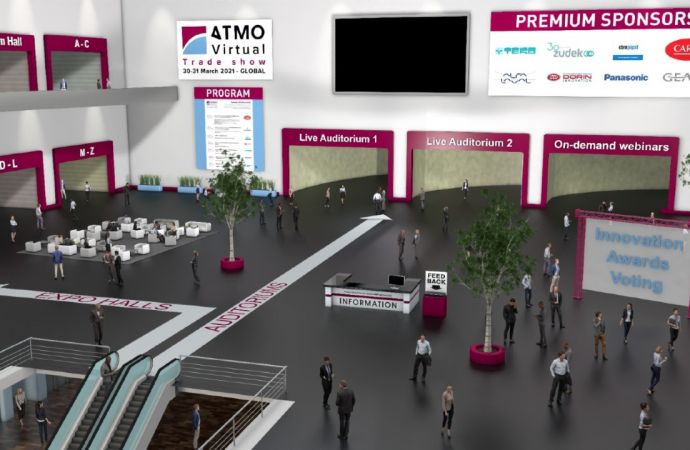Over two days representatives from developing and developed countries gathered at the joint UNIDO ATMOsphere Technology Summit, in Vienna, Austria, to discuss viable, climate friendly alternatives to HCFC refrigerants. Ammonia refrigeration, favoured around the world as a natural solution for the commercial and industrial refrigeration sectors, featured in many presentations, including from Pega Hrnjak, Eric Delforge, Caleb nelson, Jan Boone and Eric Wagner.

Organised on the 3-4 June at the UNIDO headquarters in Vienna, the Technology Summit gave participants the opportunity to learn about a range of natural solutions for the HVAC&R and foam sectors. In countries around the world, including in article 5 countries, ammonia is a very suitable low global warming potential (GWP) and zero ozone depletion potential (ODP) refrigerant that can be used as an alternative to HCFCs, whose phase-out is mandated by the Montreal Protocol. A range of Technology Case studies from the Summit featuring ammonia as a refrigerant, demonstrate its successful use from Egypt to the USA.
Many Options for Natural Refrigerants, Pega Hrnjak
Pega Hrnjak presented an overview of the main natural refrigerant alternatives with serious potential to become mainstream options: CO2, ammonia and hydrocarbons. Hrnjak considers ammonia chillers to be an especially attractive solution for developing countries. Moreover, developments such as hermetic compressors, microchannel condensers and Ni brazed plate evaporators have made the safe use of ammonia possible in low-charge applications. However, costs remain an issue for the widespread adoption of naturals that needs to be overcome. Prof. Hrnjak also stressed the need to recognise the differences in properties between the natural refrigerants in order to fully exploit their heat transfer advantages.
Technology and Market Trends, Industrial Refrigeration, Eric Delforge, Mayekawa
Eric Delforge, from Mayekawa presented various cases using ammonia, carbon dioxide and water installed in food production and distribution centres, as well as the successful application of hydrocarbons in chemical plants. According to Mr Delforge, the growing demand for frozen food in developing countries will result in a growing demand for refrigeration systems. Ammonia plants have the potential to meet this growing demand.
Mayeakwa, whose core business is industrial refrigeration, has over 90 years of experience with ammonia, and has developed a new series of screw and piston compressor blocks, including:
Mayeakwa, whose core business is industrial refrigeration, has over 90 years of experience with ammonia, and has developed a new series of screw and piston compressor blocks, including:
- Model J: features new profile rotors (5 x 6), 10% higher efficiency, “Vi” automatic variable optimised operation control, low vibration, low noise and a flanged motor.
- M-type: 10% higher efficiency, wider operation range, bigger capacities
- Ammonia semi-hermetic piston chiller
In concluding his presentation Mr Delforge said that the required knowledge to operate and service natural refrigerant installations exists in developing countries, and that these HFC-free solutions will continue becoming more efficient and cost-effective.
Natural Refrigerants – U.S. Considerations, Caleb Nelson, CTA Architects
Caleb Nelson's presentation looked at US demand for alternative refrigerants, where CO2 is becoming very common, despite there being no HFC legislation, tax or production quotas. CO2 transcritical installations are only being planned in the Northern US States, but CO2/NH3 systems are being installed further south. Caleb's conclusion is that NH3/CO2 is an efficient option to obtain 100% natural refrigeration in virtually in any country/climate, and CO2 transcritical use in warmer developing countries could expand— where waste heat is usable.
Field Cases with Natural Refrigerants in Developing Countries, Jan Boone, Mayekawa
Jan Boone presented a history of MYCOM compressor and development, which started in 1924 with the piston compressor. Today there are more than 100,000 MYCOM piston compressors installed in over 100 countries, including at CERN, Switzerland. Mr Boone presented Mayekawa-MYCOM compressors installed in various industries between 1976 and 2013 in Serbia, Croatia, Macedonia, Bosnia-Herzogovina, Russia and Egypt. In Serbia for example, one compressor has operated 135,000 hours since 1987. According to Boone MYCOM installations can be found across a range on industries including dairies, food processing and distribution centres, wine and soft drinks production, motor oil refineries, and many others.
Use of Natural Refrigeration in Industrial Plants in Article 5 Countries, Erich Wagner
Erich Wagner from Wagner Contracting presented a refrigeration system installed at the "Vinnitsky Broiler” plant, which has an installed refrigeration capacity of about 20 MW. The refrigeration plant situated in a 100m hall and features:
- 16 Mayekawa-MYCOM compressors
- 2 carton freezers with 15 y/h freezing capacity
- 20 veritcal plate freezers
- 4 horizontal plate freezers
- Blast and spiral freezers
- Water, glycol and brine chillers
- 5 evapotative condensers
MORE INFORMATION
Related stories



